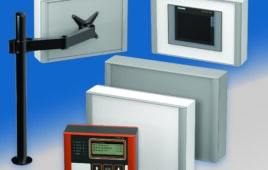Laird (LRD: London) has developed a smaller, more efficient option for precise thermal management in compact CO2 incubators using thermoelectric assemblies (TEAs). When employed with the advanced SR-54 temperature controller, thermoelectric assemblies use less energy to maintain the desired temperature range, lowering the cost of ownership when compared to standard compressor-based systems.
 A cell culture incubator is designed to maintain a constant temperature and high humidity for the growth of tissue culture cells under a CO2 atmosphere. Typical temperature settings range from 4°C to 80°C, with relative humidity between 95% and 98% and CO2 concentrations ranging from 0.3 to 19.9%. Historically, temperature in CO2 incubators were controlled either by a water bath that circulated through the walls of the cabinet (water jacketed), compressor-based systems or by electric coils that gave off radiant heat. Modern units now use solid-state thermoelectric-based cooling for temperature control.
A cell culture incubator is designed to maintain a constant temperature and high humidity for the growth of tissue culture cells under a CO2 atmosphere. Typical temperature settings range from 4°C to 80°C, with relative humidity between 95% and 98% and CO2 concentrations ranging from 0.3 to 19.9%. Historically, temperature in CO2 incubators were controlled either by a water bath that circulated through the walls of the cabinet (water jacketed), compressor-based systems or by electric coils that gave off radiant heat. Modern units now use solid-state thermoelectric-based cooling for temperature control.
Laird’s thermoelectric assemblies (TEAs), including the AA-230 Series and AA-250 Series, offer a high coefficient of performance (COP) to minimize power consumption when cooling or heating CO2 incubators. Based on a standard platform, TEAs can be customized to meet application requirements. These TEAs offer 230 Watts and 250 Watts of cooling power at Delta T=0°C respectively. Using impingement flow to transfer heat, the AA-230 and AA-250 Series offer dependable, compact performance by cooling objects via convection. The solid state construction requires less maintenance than standard compressor-based cooling systems.
Temperature stability is vital in CO2 incubators, and Laird’s TEAs, driven by the SR-54 programmable microcontroller, deliver temperature stability to within ± 0.15°C of the temperature set point in cooling and heating mode. With built-in monitoring and closed loop feedback control intelligence, the SR-54 temperature controller provides monitoring and alarm functionality, including identification of a problematic fan, thermoelectric module, over-temperature thermostat and temperature sensor failure — all of which are critical to maximizing CO2 incubator uptime. The ready-to-use controller requires minimal programming out of the box and is easily attached to a TEA or system enclosure. The controller also lowers operational noise, as fans are turned off once the specified temperature has been reached inside the respective incubator column.
Active humidity control ensures short recovery times after the door has been opened and minimizes vaporization in the interior.
“Laird’s compact thermoelectric assemblies have a size-to-cooling capacity ratio that offers customers a significant design advantage compared to other technologies. When combined with the SR-54 temperature controller, our cooling systems reach the temperature set-point quickly, without temperature overshoots or significant ramp down, shortening the incubation cycle time,” said Anders Kottenauer, Senior Vice President of Laird’s Engineered Thermal Systems Business. “Standard off-the-shelf controllers are too complex, or do not have basic alarm and control features required to operate a TEA effectively. Installing this ready-to-use SR-54 bi-polar temperature controller can save engineers hundreds of product development hours, as it has been optimized to run thermoelectric assemblies.”
Laird
www.laird.com
Filed Under: Cabinets • enclosures • control panels





Tell Us What You Think!